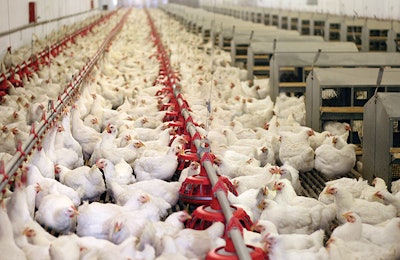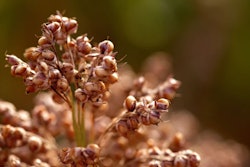
Research from The Netherlands reveals that feeding insect larvae can improve the welfare of broiler chickens.
Exploring ways to reduce our impacts on the environment, there has been growing interest in insects in the diet of the human population. They offer potential as a direct food source and, indirectly, for food-producing animals.
Recent investigations show that insect species can be grown using a wide range of waste materials. Furthermore, larvae and adults provide useful sources of protein and other nutrients. Now, researchers at Wageningen University and Research (WUR) in The Netherlands report that provision of insect larvae can improve some measures of broiler welfare.
Encouraging the natural behavior of foraging for insect larvae, the birds were generally more active, and this resulted in better leg health. Crucially from the commercial point of view, there were no adverse effects of broiler performance.
Natural foraging behavior
In the first of two recently published WUR trials, broilers kept under standard commercial conditions were fed larvae of the black soldier fly daily. Larvae were fed in one of two amounts, and at one of two frequencies during the day. This resulted in five experimental treatments to identify the best feeding program.
Ross 308 male chicks were used in both trials at the WUR facilities under conditions close to commercial practice. For the first seven days, all the birds received the same chick starter diet.
Five treatments were used in the first experiment. While birds in the control group were fed a standard diet throughout, the rest were offered BSF larvae sprinkled onto the litter. Amounts of larvae fed were equivalent to 5% or 10% of the birds’ daily dry matter intake. These quantities were fed at regular intervals, either twice or four times each day.
During the six-week experiment, the birds’ activities were observed and noted frequently.
“We really saw that the broilers were motivated all day long to get to the larvae,” said researcher Allyson Ipema. “The broilers showed a lot of natural foraging behavior. They kept scratching and pecking at the larvae.”
More activity, better leg health
Although activity declined in all groups with age, broilers receiving the live larvae in the litter were more active and spent more time walking, pecking at the ground and foraging.
At the end of the six-week trial, all birds were assessed for their leg health.
Incidence of foot pad dermatitis was low, and not affected by treatment. While not a serious issue in any group, the controls had more hock burns than the birds receiving the higher level of larvae.
Elevated gait scores occurred more in the control group than the birds receiving more larvae, or the lower amount more often.
This led the researchers to link greater activity of the larva-fed birds with better leg health.
No negative effects on performance
Feeding of the larvae was not associated with adverse impacts on the performance of the broilers in the WUR experiment.
In the trial design, the composition of the grower diet was adjusted so that the expected energy and nutrient intake of the birds on all treatments was similar.
When all the broilers were weighed on day 42 — at the end of the trial — there were no statistically significant effect of larval feeding on bodyweight. Only the group receiving the higher amount of larvae less frequently were significantly lighter than control group fed the standard diet only (P<0.05; 2.726 kg versus 2.890 kg, respectively).
In summary, prolonged access to insect larvae offers great potential for better bird well-being, the researchers concluded.
They identified a further advantage of the insect larvae, which can be grown on manure or waste products.
“This also makes them a potentially sustainable and circular food source, said another member of the WUR team, associate professor Liesbeth Bolhuis.
The WUR study — titled “Provisioning of live black soldier fly larvae (Hermetia illucens) benefits broiler activity and leg health in a frequency- and dose-dependent manner” by Ipema and others —was published in Applied Animal Behaviour Science last year.
Latest experiment
After the original experiment, the group at WUR investigated ways of using the insect larvae to further increase broiler activity.
As well as using the scattering of larvae to make up 10% of the daily dry mater intake used in the previous trial, the group added two additional treatments. These involved larvae amounting to 5% of daily intake in seven portions throughout the day, and providing the larvae in transparent plastic with holes made the birds work a little harder for their tasty treats. Filled with the daily allowance of larvae, these tubes were placed in the broiler pens once a day.
“Because the chicks have to make an effort to get the larvae out of the tubes, they spend a large part of the day on it,” said Bolhuis.
Both methods of prolonging access to the larvae — providing them seven times a day, or in the tube — resulted in the most activity of the broilers. These treatments were not associated with any negative impacts on performance or health of the birds.
This follow-up study by the WUR scientists was published in late 2020 in Nature Scientific Reports. Title of the research paper is “Long-term access to live black soldier fly larvae (Hermetia illucens) stimulates activity and reduces fearfulness of broilers, without affecting health.
Insects for poultry
Other poultry are attracted to live insects. In a recent WATT Poultry blog was a report of an egg farmer who offers a supplement of live BSF larvae to his free-range layers. The hens clearly very much enjoyed eating them.
As part of its latest examination of the future of the region’s agriculture, the European Commission has explored the potential of insect farming to produce protein for animal feeds.
Another study revealed that using insect proteins as sustainable alternatives to current feeding practices could benefit the environment as well as helping animal feed companies become more efficient.

















